
The Douglas YOA-5 was an Amphibious aircraft designed for the United States Army Air Corps. Although a prototype was built, it did not enter production.
The Martin XB-33 Super Marauder was a proposed World War II American bomber aircraft. It was designed by the Glenn L. Martin Company as the Martin Model 190 and was a high-altitude derivative of the company's B-26 Marauder. Two different designs were developed, first as a twin-engined aircraft and then as a four-engined aircraft. The four-engined version was ordered by the United States Army Air Forces, but the program was cancelled before any aircraft were built.
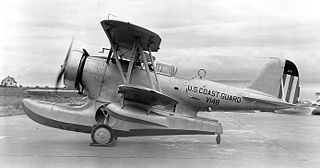
The Grumman JF "Duck" was an American single-engine amphibious biplane built by Grumman for the United States Navy during the 1930s. The J2F Duck was an improved version of the JF, with its main difference being a longer float.

The Naval Aircraft Factory SBN was a United States three-seat mid-wing monoplane scout bomber/torpedo aircraft designed by the Brewster Aeronautical Corporation and built under license by the Naval Aircraft Factory in Philadelphia, Pennsylvania. The landing gear was similar to that on the Brewster F2A Buffalo fighter aircraft. The SBN had non-folding wings with perforated flaps.
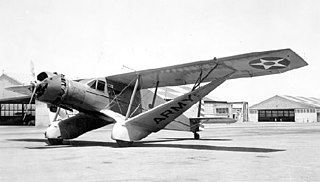
The Bellanca Aircruiser and Airbus were high-wing, single-engine aircraft built by Bellanca Aircraft Corporation of New Castle, Delaware. The aircraft was built as a "workhorse" intended for use as a passenger or cargo aircraft. It was available with wheels, floats or skis. The aircraft was powered by either a Wright Cyclone or Pratt and Whitney Hornet engine. The Airbus and Aircruiser served as both commercial and military transports.

The Consolidated O-17 Courier was an observation and training aircraft used by the United States National Guard.

The Consolidated Model 17 Fleetster was a 1920s American light transport monoplane aircraft built by the Consolidated Aircraft Corporation.
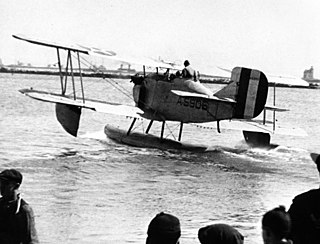
The Elias EM was a 1920s American general-purpose and marine expeditionary biplane built by Elias.

The Curtiss T-32 Condor II was a 1930s American biplane airliner and bomber aircraft built by the Curtiss Aeroplane and Motor Company. It was used by the United States Army Air Corps as an executive transport.

The Loening OL, also known as the Loening Amphibian, was an American two-seat amphibious biplane designed by Grover Loening and built by Loening for the United States Army Air Corps and the United States Navy.
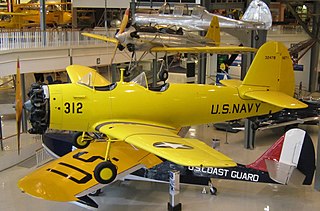
The Timm N2T Tutor is an American training monoplane built by the Timm Aircraft Corporation for the United States Navy as the N2T-1.
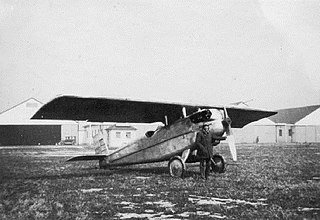
The Dornier Do H Falke was a German single-seat fighter, designed by Claude Dornier and built by Dornier Flugzeugwerke. Although an advanced design for its time, being evaluated by the United States Navy as the Wright WP-1, it did not go into production.

The Keystone NK or Keystone Pup was a two-seat biplane trainer built by Keystone Aircraft for the United States Navy.

The Berliner-Joyce OJ was an American biplane observation floatplane developed by the Berliner-Joyce Aircraft for the United States Navy during the early 1930s.

The Vought O5U was a 1930s prototype American observation floatplane to meet a United States Navy requirement for a catapult launched scouting aircraft. The contract was won by Curtiss who went on to produce the SOC Seagull; only one O5U was built.

The Sikorsky XHJS-1, was developed by Sikorsky Aircraft to meet a Naval requirement for a utility helicopter. The XHJS-1 was not ordered into production and only two prototypes were built.

The Martin N2M was a prototype American primary training biplane, built for the United States Navy by the Glenn L. Martin Company. It was never accepted by the Navy and only the prototype was built.

Naval Aircraft Factory NO was an American short-range reconnaissance/gun spotting aircraft of the 1920s. A single-engined three-seat biplane with alternative floats or wheels, six were built for the U.S. Navy.

The Bellanca SE was an American carrier-based scout monoplane designed and built for the United States Navy by the Bellanca Aircraft Company.

G Elias & Brother was and American manufacturer of cabinets and aircraft based in Buffalo, New York in the 1920s. A.G. Elias sat on the Manufacturers Aircraft Association's board of directors along with President Frank H. Russell, VP Glenn L. Martin, Charles L. Laurence, Chance M. Vought, S.S. Bradley, George P. Tidmarsh, and Donald Douglas. E.J Elias promoted the construction of a Buffalo municipal airport to aid the local fledgling airplane industry of five aviation companies constructing airplanes and airplane parts. From 1920 to 1925, Elias company's chief engineer, David Earle Dunlap (1896-1957), designed the Elias EM-2 Expeditionary planes. He designed the NBS-3 bomber fuselage and the Elias M-1 Mail plane. Dunlap's Elias TA-1 design was the first United States Army Air Corps Trainer to have a radial engine. After tests a McCook Field, the Army Air Corps selected other manufacturers over the Elias bomber and trainer. The company designed the Elias EM-1 to meet requirements for a multirole amphibian marine expeditionary aircraft. Elias delivered six production Elias EM-2 aircraft with Liberty engines to the United States Navy in 1922.


















